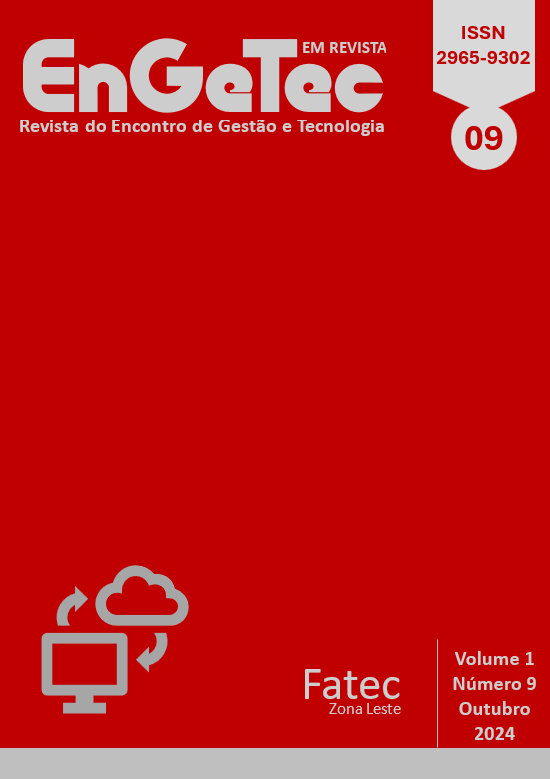Simulation Applied in Urban Public Transport
Analysis of Line 407L/10 Barro Branco – Guilhermina Esperança in Morning Flow Schedule
DOI:
https://doi.org/10.5281/zenodo.13367897Keywords:
Transportation, Simulation, Mobility, AccessibilityAbstract
The purpose of this article is to provide a qualitative analysis of the operation of the buses on line 407L, which runs from Barro Branco to Guilhermina Esperança during peak hours, in order to understand the possible bottlenecks and disruptions in its functioning. To achieve this, in addition to insights gained through analyses of reports and publications related to the line, simulation will be used in conjunction with the ARENA software to identify critical points and find possible solutions to enhance the mobility and accessibility of the operation. The line will be analyzed during key hours (which are the ones that present the most operational issues), including the morning rush hour when there is a significant flow of people commuting and the afternoon rush hour when a large number of users return from their morning bus rides. The analysis did not extend to secondary hours, as it is understood that by addressing the line's issues during its most critical operating period, the disruptions identified during secondary operating hours will likely be resolved.
Downloads
References
Araújo, M. R. M. de ., Oliveira, J. M. de ., Jesus, M. S. de ., Sá, N. R. de ., Santos, P. A. C. dos ., & Lima, T. C.. (2011). Transporte público coletivo: discutindo acessibilidade, mobilidade e qualidade de vida.
Psicologia & Sociedade, 23(3), 574–582. https://doi.org/10.1590/S0102-71822011000300015
BANKS, Jerry. (1998). Principles of simulation. In: BANKS, J. (Ed.) (1998). Handbook of Simulation. New York: John Wiley & Sons, 1998.
Bertucci, Jonas de. Os benefícios do transporte coletivo. Repositório do Conhecimento do IPEA. 2011. 11 p. Disponível em:< http://repositorio.ipea.gov.br/bitstream/11058/5652/1/BRU_n5_beneficios.pdf>. Acesso em: 25 de outubro. 2023.
Cardoso, C. E. P. (2008). Análise do transporte coletivo urbano sob a ótica dos riscos e carências sociais. Tese de Doutorado, Programa de Pós-graduação em Serviço Social, Pontifícia Universidade Católica de São Paulo, São Paulo, SP.
Costa, L. C. Teorias das Filas: Apostila. Disciplina Teoria das Filas e Simulação, Curso de Ciência da Computação. Centro Tecnológico da Universidade Federal do Maranhão – UFMA. Maranhão, 2006.
Linha 407L teve reforço de frota, mas ainda continua lotada, reclamam passageiros. Diário do Transporte, 03 de abril de 2020. Disponível em: <https://diariodotransporte.com.br/2020/04/03/linha-407l-10-teve-reforco-de-frota-mas-ainda-continua-lotada-reclamam-passageiros/> Acesso em: 01 de outubro. 2023
Fernandes, Alexandra Cristina Moreira. Simulação de linha de produção usando a Plataforma ARENA. Bragança – 2012.
Mobilidade Urbana e Transporte Público em SP. Mobilize, setembro de 2016. Disponível em: <https://www.mobilize.org.br/midias/pesquisas/mobilidade-urbana-e-transporte-publico-em-sp.pdf>.Acesso em: 01 de outubro. 2023.
Rodrigues, Pablo Einstein. Uma breve introdução à teoria das filas. – Goiânia: Instituto Federal de Educação, Ciência e Tecnologia de Goiás, 2022.
Raia JR., Archimedes Azevedo (2000) – Acessibilidade e Mobilidade na Estimativa de um Índice de Potencial de Viagens utilizando Redes Neurais Artificiais e Sistemas de Informações. Tese (Doutorado) – Escola de Engenharia de São Carlos, Universidade de São Paulo.
SPTrans. SPTrans, janeiro de 2023. Disponível em: <https://www.sptrans.com.br/sptrans/>. Acesso em 30 de outubro. 2023.
PARAGON. Introdução à Simulação com ARENA. São Paulo, SP: ENEGEP, 2005.
Taschner, Suzana e Bogus, Lúcia M.(2001) – São Paulo: Caleidoscópio Urbano. São Paulo em Perspectiva, jan./mar. 2001, vol.15, no .1. Disponível em: <https://www.scielo.br/j/spp/a/cL4PR4fqSJYhvGFShHzRCXx/?format=pdf&lang=pt>. Acesso em: 30 de outubro. 2023.
Downloads
Published
How to Cite
Issue
Section
License
Copyright (c) 2024 Graziely Couto da Silva , Juliana da Silva Costa , Rafael Gonçalves de Jesus

This work is licensed under a Creative Commons Attribution-NonCommercial-ShareAlike 4.0 International License.
Engetec em Revisa © 2024 by Fatec da Zona Leste is licensed under CC BY-NC-SA 4.0
Copyright Policy
By submitting a manuscript for publication in EnGeTec em Revista, the authors agree, in advance and unrestrictedly, to the following terms:
- The authors retain the copyright and grant EnGeTec em Revista the right of first publication of the manuscript, without any financial burden, and renounce any other remuneration for its publication in EnGeTec em Revista.
- When submitted to EnGeTec em Revista, the manuscript is automatically licensed under the Creative Commons Attribution License, which allows the sharing of the work with acknowledgment of authorship and initial publication in EnGeTec em Revista.
- Authors are authorized to enter into additional contracts separately, for non-exclusive distribution of the version of the work published in EnGeTec em Revista (publish in repositories or as a book chapter), with acknowledgment of the initial publication in EnGeTec em Revista, provided that such agreement does not imply an endorsement of the content of the manuscript or of the new vehicle by EnGeTec em Revista.
- Authors are allowed and encouraged to publish and distribute their work online, in institutional repositories, for example after the editorial process is completed.
- The authors warrant that they have obtained proper permission from their employers for the transfer of rights under this agreement, if those employers own any copyright in the manuscript. In addition, the authors assume any and all responsibility for possible infringements of the copyright of these employers, exempting EnGeTec em Revista from any and all liability in this regard.
- The authors assume all responsibility for the content of the work, including the due and necessary authorizations for data disclosure. collected and results obtained, exempting EnGeTec em Revista from any and all responsibility in this regard.














